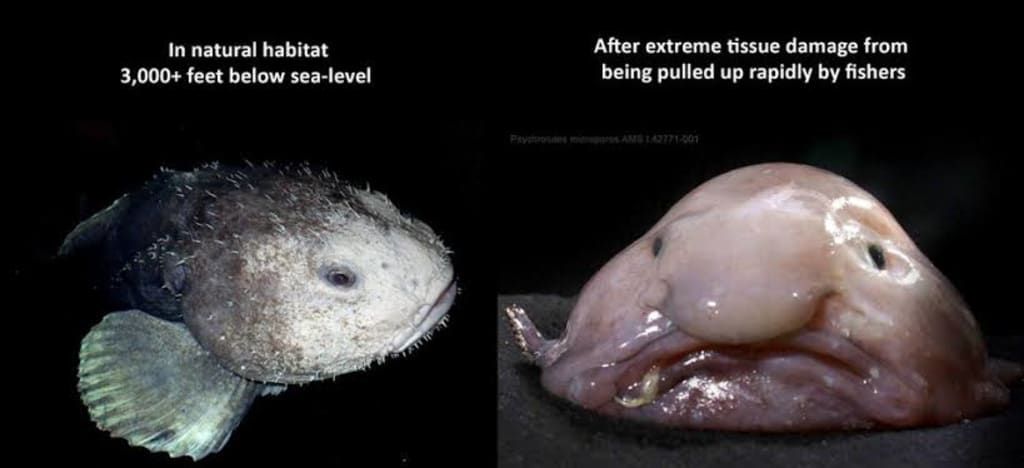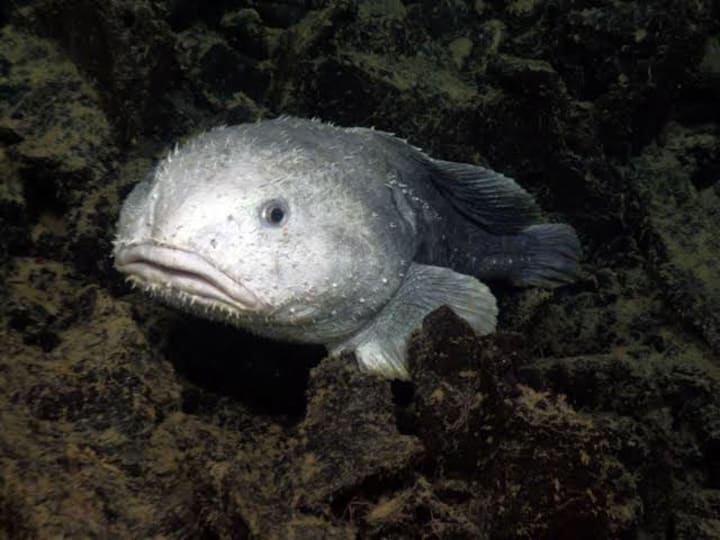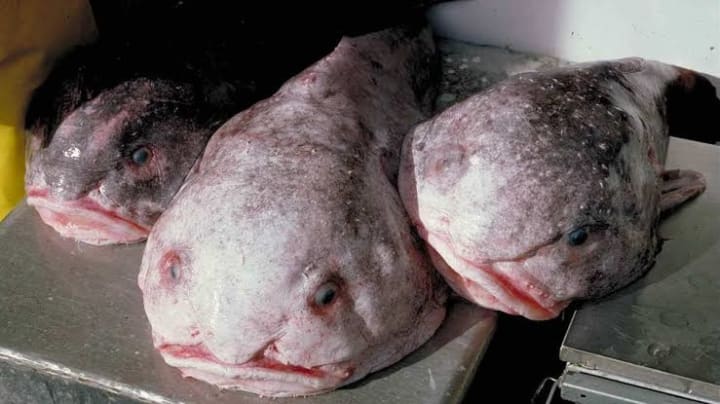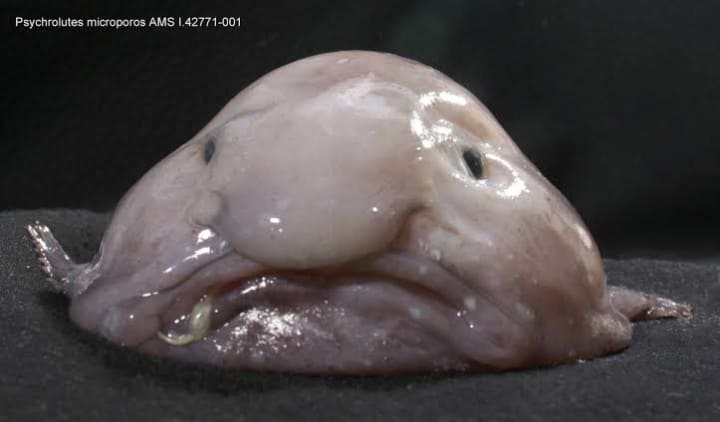
The blobfish (Psychrolutes marcidus) is a deep-sea fish that inhabits the waters off the coasts of Australia, New Zealand, and Tasmania. It is known for its unique appearance, which has been described as "ugly," "disturbing," or even "freakish."
The blobfish has a gelatinous body that lacks muscle, allowing it to float effortlessly in the water. It is typically a pale pink or gray color, but appears much different when brought to the surface due to the change in pressure. The fish lives at depths of up to 1200 meters and feeds on invertebrates such as crabs and lobsters.
Despite its unappealing appearance, the blobfish has become somewhat of an internet sensation and has been affectionately dubbed the "world's ugliest animal." It is important to note, however, that beauty is subjective and all animals play important roles in their respective ecosystems.
“The History of a Blob Fish”

The history of the blobfish (Psychrolutes marcidus) is not well documented, as it is a deep-sea fish that has only recently been discovered and studied by scientists. The blobfish was first described in 1926 by Australian ichthyologist Allan Riverstone McCulloch, who collected a specimen off the coast of New South Wales, Australia.
For many years, the blobfish was of little interest to scientists or the public, as it was a rare and obscure species that lived at great depths and was rarely encountered. However, in recent years, the blobfish has gained attention and become somewhat of an internet sensation, thanks to its unusual appearance and the widespread sharing of photos and videos online.
In 2013, the blobfish was named the "world's ugliest animal" by the Ugly Animal Preservation Society, a UK-based organization that aims to promote the conservation of unattractive and often overlooked species. The group selected the blobfish as their mascot in an effort to raise awareness of the importance of preserving all species, regardless of their appearance.
Despite its newfound fame, the blobfish remains a mysterious and poorly understood species, as its remote habitat makes it difficult to study. Scientists continue to investigate the biology and behavior of the blobfish in an effort to learn more about this unique and fascinating fish.
Here are some interesting facts about the blobfish:

The blobfish is a deep-sea fish that lives at depths of up to 1200 meters, where the pressure is up to 120 times greater than at the surface.
The blobfish has a gelatinous body that is less dense than water, allowing it to float effortlessly in the water.
The blobfish is typically a pale pink or gray color, but appears much different when brought to the surface due to the change in pressure.
The blobfish feeds on invertebrates such as crabs and lobsters.
The blobfish has a face only a mother could love! Its unusual appearance has led to it being called the "world's ugliest animal."
Despite its unappealing appearance, the blobfish plays an important role in its deep-sea ecosystem, as it helps to maintain a balance between predator and prey populations.
Blobfish have small eyes, but they are adapted to their dark habitat and can detect movement and shadows.
Blobfish have a lifespan of up to 130 years.
Blobfish are not actually squishy like their name suggests. Their bodies are more like a firm jelly consistency.
The blobfish is not a good swimmer, but it does not need to be because it primarily drifts along with ocean currents.
How do Blob Fish Survives in a deep Sea
Blobfish (Psychrolutes marcidus) are adapted to survive in their deep-sea habitat, where the environment is extreme and resources are scarce.

Here are some ways in which blobfish survive:
Adaptation to high pressure: Blobfish live at depths of up to 1200 meters, where the pressure is up to 120 times greater than at the surface. To survive in this environment, blobfish have a gelatinous body that is less dense than water, allowing them to float effortlessly. They also have few bones, muscles, and other tissues that would be compressed at such high pressure.
Feeding on opportunistic prey: Blobfish feed on a variety of invertebrates such as crabs, lobsters, and other animals that drift by them. Since food is scarce at such depths, blobfish are opportunistic feeders, taking advantage of any prey that crosses their path.
Energy conservation: To survive in a low-energy environment, blobfish have a very slow metabolism and move very little. This helps them conserve energy and survive on the limited food resources available in their habitat.
Adaptation to low light: The deep-sea environment is dark, and blobfish have adapted to see in these conditions. They have small eyes that are adapted to detect movement and shadows, which helps them locate prey and avoid predators.
Long lifespan: Blobfish have a lifespan of up to 130 years, which allows them to take advantage of any food resources that become available over a long period of time.
Overall, the blobfish's unique adaptations help it survive in a challenging deep-sea environment, where resources are scarce and the pressure is extreme.
About the Creator
Lydia Babu
Greeting’s!!! I’m Lydia who is very Passionate about writing!!!
Enjoyed the story? Support the Creator.
Subscribe for free to receive all their stories in your feed. You could also pledge your support or give them a one-off tip, letting them know you appreciate their work.






Comments
There are no comments for this story
Be the first to respond and start the conversation.